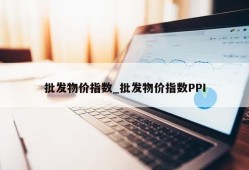批发物价指数_批发物价指数英文
- 走势
- 2023-07-17
- 92

What Is Wholesale Price Index?
Have you ever wondered about the secret behind those price tags at your favorite store? How do they determine the prices of goods? Well, my curious friends, let me enlighten you about the Wholesale Price Index (WPI).
1. Decoding the Wholesale Price Index
Imagine a group of economists huddled together, crunching numbers and analyzing the trends in the market. They are like detectives investigating the forces that shape the prices of goods sold in bulk. The Wholesale Price Index is their ultimate tool.
The Wholesale Price Index (WPI) is an economic indicator that measures the average changes in prices of goods at the wholesale level. It captures the price movement of various commodities such as grains, metals, and fuels, among others.
Let's take an example to understand it better. Imagine the price of wheat suddenly skyrockets due to a drought in a major wheat-producing country. This increase in the price of wheat will be reflected in the Wholesale Price Index, indicating a rise in the overall price level.
2. Why Does Wholesale Price Index Matter?
Now that you know what Wholesale Price Index is, you might wonder, why should we care? Well, my dear readers, the Wholesale Price Index provides valuable insights into the health of the economy and helps investors make informed decisions.
For stock market enthusiasts, the Wholesale Price Index can act as a crystal ball, giving them a glimpse of what lies ahead. A rising Wholesale Price Index implies inflationary pressures, which can impact the stock market negatively. On the other hand, a declining WPI could indicate deflationary pressures and possibly be a sign of a struggling economy.
3. Unleashing the Power of Wholesale Price Index
Now that we understand the significance of the Wholesale Price Index, let's unleash its power in four major investment areas: stock market, foreign exchange market, mutual funds, and securities.
In the Stock Market:
The Wholesale Price Index can be a guide for investors to identify sectors that are likely to outperform in times of inflation. Keeping an eye on the industries with high WPI can help investors ride the wave and make profitable investments.
In the Foreign Exchange Market:
The Wholesale Price Index can also impact the value of a country's currency. Higher Wholesale Price Index suggests higher inflation, which leads to a decrease in the currency's value. Understanding the correlations between WPI and exchange rates can give forex traders an edge.
In Mutual Funds:
When analyzing mutual funds, it is essential to consider the impact of changing Wholesale Price Index levels on the performance of different sectors. Some mutual funds may be more sensitive to inflationary pressures, while others may benefit from deflationary conditions. Studying the Wholesale Price Index can help investors select mutual funds aligned with their investment goals.
In Securities:
For investors in government securities, the Wholesale Price Index serves as a valuable tool in predicting future changes in interest rates. When inflation is on the rise, central banks tend to tighten monetary policies by increasing interest rates. Monitoring the Wholesale Price Index can provide insights into potential shifts in interest rates, allowing investors to make well-informed decisions regarding securities.
So, my dear readers, next time you come across the mysterious Wholesale Price Index, remember that it holds the key to understanding the pulse of the economy and making wise investment choices. Happy investing!
Summary: The Wholesale Price Index (WPI) is an economic indicator that measures the average changes in prices of goods at the wholesale level. It provides valuable insights into the health of the economy and aids investors in making informed decisions in the stock market, foreign exchange market, mutual funds, and securities. Understanding WPI can unlock the potential for profitable investments and help navigate the complexities of the financial world.

















